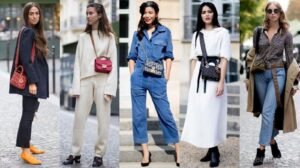The Evolution of Women’s Fashion: Trends and Influences

Introduction to Women’s Fashion
Women’s fashion has long been a mirror reflecting societal changes, cultural shifts, and economic developments. From the elaborate garments of the Renaissance to the minimalist styles of the 21st century, the evolution of women’s fashion tells a rich story of transformation and adaptation. The significance of women’s fashion is not merely confined to aesthetics; it embodies a dynamic dialogue between personal expression and broader societal trends.
Throughout history, women’s fashion has been influenced by a multitude of factors. Cultural norms and values have dictated what is considered appropriate or fashionable at any given time. For instance, the modesty of Victorian attire was a direct reflection of the era’s moral values. Conversely, the flapper dresses of the 1920s symbolized a break from tradition and a new wave of female liberation. Social movements have also left indelible marks on women’s fashion. The feminist movements of the 20th century, for example, saw the rise of more functional and less restrictive clothing, aligning with the growing demand for gender equality.
Economic factors play a crucial role in shaping fashion trends. During times of economic prosperity, fashion tends to be more extravagant and experimental. Conversely, during economic downturns, simpler and more practical styles prevail. The shifts in women’s fashion also reflect changes in production technologies and materials, from hand-sewn garments to mass-produced clothing enabled by the Industrial Revolution.
This blog post aims to explore the intricate evolution of women’s fashion, shedding light on the various trends and influences that have shaped it over the centuries. Readers can expect to gain a deeper understanding of how women’s fashion has evolved in response to changing cultural, social, and economic landscapes. We will delve into specific eras, highlighting key trends and notable influences, to provide a comprehensive overview of this fascinating journey.
Historical Milestones in Women’s Fashion
Women’s fashion has undergone a dynamic transformation across various historical epochs, each distinctively reflecting the societal, cultural, and economic undercurrents of its time. Ancient civilizations, such as Egypt and Rome, laid the groundwork for early fashion trends. Egyptian women often adorned themselves in linen garments, with intricate beadwork symbolizing status and beauty. In contrast, Roman women favored stolas and pallas, signifying both modesty and elegance.
The Renaissance era marked a significant departure from medieval simplicity, embracing opulence and grandeur. Women’s attire during this period was characterized by elaborate gowns featuring luxurious fabrics like velvet and silk, often adorned with intricate lace and embroidery. These garments not only highlighted the wearer’s social standing but also celebrated the human form and artistic expression, influenced by the period’s resurgence in art, literature, and philosophy.
The Victorian era introduced a more conservative and refined approach to women’s fashion. This period was synonymous with corsets, crinolines, and bustles, which emphasized an hourglass figure. The elaborate, modest dresses, often layered and accessorized with bonnets and gloves, mirrored the era’s strict societal norms and the burgeoning Industrial Revolution’s impact on fabric production and garment construction.
The Roaring Twenties brought a dramatic shift, characterized by the flapper dress, which epitomized liberation and nonconformity. These dresses, often adorned with fringe and sequins, were shorter and looser, allowing greater freedom of movement. This fashion revolution was a response to the post-World War I societal changes, including women’s suffrage and a newfound spirit of independence and modernity.
Post-war fashion in the mid-20th century saw the rise of designers like Christian Dior, who introduced the “New Look” in 1947. This style marked a return to femininity with cinched waists, full skirts, and an emphasis on an hourglass silhouette. It reflected a desire for luxury and normalcy following the austerity of wartime. The post-war era also witnessed the emergence of ready-to-wear fashion, making stylish clothing more accessible to the average woman.
Each of these historical milestones has contributed to the rich tapestry of women’s fashion, showcasing how attire evolves not merely as a reflection of aesthetic preferences but also as a mirror to the shifting landscapes of society and culture.
Influential Fashion Icons and Designers
The evolution of women’s fashion has been significantly shaped by numerous influential fashion icons and designers. Among the most notable figures is Coco Chanel, whose innovative designs revolutionized women’s fashion in the early 20th century. Chanel’s emphasis on simplicity, comfort, and elegance introduced a new era of fashion, moving away from the restrictive corsets and voluminous skirts of the past. Her creation of the little black dress and the Chanel suit remains a timeless contribution to women’s wardrobes.
Audrey Hepburn, another iconic figure, left an indelible mark on fashion through her collaboration with designer Hubert de Givenchy. Hepburn’s minimalist yet sophisticated style, epitomized by her iconic black dress in “Breakfast at Tiffany’s,” continues to inspire designers and fashion enthusiasts around the world. Her influence extended beyond the screen, promoting a chic and effortless elegance that remains relevant today.
In contemporary times, Anna Wintour, the editor-in-chief of Vogue, has become a powerful force in the fashion industry. Wintour’s keen eye for talent and trends has propelled numerous designers to fame, while her editorial decisions have shaped the direction of fashion for decades. Her signature bob haircut and oversized sunglasses have become synonymous with fashion authority and influence.
Additionally, modern influencers such as Rihanna have redefined fashion norms through their bold and innovative styles. Rihanna’s ventures with her Fenty brand have challenged traditional beauty standards and promoted inclusivity within the fashion industry. Her fearless approach to fashion, blending streetwear with high fashion, has made her a trendsetter and a source of inspiration for many.
These influential figures and designers have not only contributed iconic pieces and trends but have also redefined the standards and expectations of women’s fashion. Their enduring legacies continue to inspire and shape the ever-evolving landscape of fashion.
Major Trends in Women’s Fashion
Over the decades, women’s fashion has been characterized by a series of influential trends that have shaped and redefined style. One of the most iconic trends is the little black dress, popularized by Coco Chanel in the 1920s. This timeless piece has evolved from its simple, elegant origins to incorporate modern designs and fabrics, remaining a staple in women’s wardrobes worldwide.
The power suit emerged in the 1980s as a symbol of women’s growing presence in the corporate world. Initially characterized by broad shoulders and tailored lines, the power suit has undergone several transformations, adapting to contemporary aesthetics while maintaining its essence of strength and sophistication. Today’s power suits are more versatile, often featuring bold colors and unconventional silhouettes, allowing for greater personal expression.
The bohemian style, with its roots in the 1960s and 1970s counterculture movements, emphasizes free-spirited and eclectic fashion choices. Characterized by flowing fabrics, earthy tones, and intricate patterns, the bohemian trend has seen resurgences over the years, adapting to modern sensibilities while retaining its distinctive, relaxed vibe. This trend continues to inspire designers, merging vintage elements with contemporary fashion.
Athleisure, a relatively recent trend, blurs the lines between athletic wear and everyday fashion. Emerging in the early 2010s, athleisure combines comfort and style, making it a popular choice for a modern, active lifestyle. This trend includes items such as leggings, hoodies, and sneakers, designed to be both functional and fashionable. The evolution of athleisure reflects the growing emphasis on wellness and active living in today’s society.
Each of these major trends has not only defined its era but has also contributed to the ongoing evolution of women’s fashion. They illustrate the dynamic nature of fashion, continually adapting to cultural shifts and technological advancements, while influencing and reshaping the way women express their identities through clothing.
The Role of Media and Technology in Fashion
The evolution of women’s fashion has been significantly influenced by the advent of media and technology. Fashion magazines like Vogue and Harper’s Bazaar have historically set the stage for trends, offering a curated view of haute couture and ready-to-wear collections that shape public perception and consumer preferences. These publications not only highlight the latest in fashion but also provide a platform for designers to showcase their work, thus playing a pivotal role in trendsetting.
Television further propelled the impact of fashion through shows like “Project Runway” and “America’s Next Top Model,” which brought the intricacies of the fashion industry into living rooms worldwide. Such programs not only entertained but also educated viewers about the creative process behind fashion design, styling, and modeling. This visual medium allowed for a broader appreciation and understanding of fashion, reaching audiences that might not have otherwise engaged with the industry.
In recent years, social media platforms like Instagram and TikTok have revolutionized the way fashion is consumed and disseminated. These platforms have democratized fashion, giving rise to influencers who dictate trends and offer real-time fashion advice. The immediacy and visual nature of these platforms allow for rapid trend cycles and direct engagement with consumers, making fashion more accessible and interactive.
E-commerce has transformed the traditional shopping experience. Online retailers and fashion blogs provide a wealth of information, reviews, and styling tips, making it easier for women to make informed purchasing decisions. Websites like ASOS and Net-a-Porter have bridged the gap between high fashion and the average consumer, offering a wide range of styles at various price points. Additionally, the convenience of online shopping has changed consumer behavior, with many women now preferring to shop from the comfort of their homes.
Fashion blogs also play a crucial role in this ecosystem, offering detailed insights and personal takes on trends, thus influencing consumer preferences. These blogs often collaborate with brands to provide exclusive deals and content, further enriching the shopping experience. Through a combination of expert opinions and user-generated content, fashion blogs help maintain a dynamic and ever-evolving fashion landscape.
Sustainable and Ethical Fashion
In recent years, the fashion industry has witnessed a significant shift towards sustainable and ethical practices. This movement has gained momentum as consumers become increasingly aware of the environmental and social impacts of their purchasing decisions. Fast fashion, characterized by its rapid production cycles and low-cost garments, has faced criticism for its detrimental effects on the environment. The excessive use of water, harmful chemicals, and the massive amounts of textile waste generated have raised serious concerns about the sustainability of such practices.
The importance of ethical sourcing cannot be overstated. Ethical fashion emphasizes the need for fair labor practices, safe working conditions, and equitable wages for workers in the supply chain. Brands that prioritize ethical sourcing often collaborate with artisans and small-scale producers, ensuring that their products are produced in a manner that respects both people and the planet.
Several brands and designers are at the forefront of this sustainable fashion revolution. Stella McCartney, for instance, is renowned for her commitment to cruelty-free and eco-friendly fashion. Her collections often feature innovative materials like recycled polyester and organic cotton. Another notable example is the brand Patagonia, which has long been a pioneer in environmental activism. Patagonia not only uses sustainable materials but also encourages consumers to buy less and repair their existing clothing.
Additionally, smaller brands like Reformation and Everlane have built their reputations on transparency and sustainability. Reformation focuses on reducing waste and water usage, while Everlane is known for its transparent pricing and ethically produced garments. These brands are setting new standards in the industry, proving that fashion can be both stylish and sustainable.
The growing trend towards sustainable and ethical fashion signifies a broader cultural shift. Consumers are no longer content with the status quo; they demand accountability and responsibility from the brands they support. As this movement continues to gain traction, it is poised to reshape the future of the fashion industry, paving the way for a more sustainable and ethical approach to style.
The Future of Women’s Fashion
The future of women’s fashion is poised to be a blend of technological innovation, sustainability, and inclusivity. As advancements in smart textiles continue to evolve, garments embedded with technology are becoming more mainstream. Smart textiles, which can monitor health metrics, change colors, or even charge electronic devices, are expected to revolutionize the functionality of clothing. These innovations are not just about aesthetics but also about integrating fashion seamlessly with everyday life.
Another groundbreaking development in the fashion industry is 3D-printed clothing. This technology allows for the creation of intricate designs and customized fits that were previously unattainable. The use of 3D printing in fashion is anticipated to reduce waste significantly, as garments can be produced on-demand and tailored precisely to individual measurements. This shift could lead to a more sustainable fashion ecosystem, addressing the growing concerns about the environmental impact of fast fashion.
Inclusivity and diversity are also driving forces shaping the future of women’s fashion. There is a growing demand for brands to cater to a wider range of body types, skin tones, and cultural backgrounds. This movement towards inclusivity is not merely a trend but a fundamental change in the industry. Designers and brands are increasingly recognizing the importance of representing all women, leading to more diverse runway shows and advertising campaigns.
Expert opinions suggest that these trends are not fleeting but indicative of a long-term transformation in the fashion landscape. As consumers become more conscious of ethical considerations, the demand for transparency and responsibility in fashion production is expected to rise. Thus, the future of women’s fashion will likely be characterized by a harmonious blend of technology, sustainability, and inclusivity, creating a more personalized and ethical fashion experience for all.
Conclusion and Reflection
The exploration of women’s fashion reveals a rich tapestry of trends and influences that have shaped its evolution over the centuries. From the intricate and elaborate garments of the Victorian era to the bold and revolutionary styles of the 20th century, each period brought its unique contributions to the fashion landscape. The impact of cultural, social, and technological changes is evident in every shift, demonstrating how fashion is not just about clothing but also a reflection of the times and the society in which it thrives.
As we journey through the history of women’s fashion, we can see the dynamic interplay between tradition and innovation. The early 1900s saw women breaking free from restrictive corsets, embracing more practical and comfortable attire. The mid-20th century introduced a burst of creativity with designers like Coco Chanel and Christian Dior, who redefined elegance and femininity. In recent decades, the rise of fast fashion and the digital revolution have democratized fashion, making it more accessible and diverse than ever before.
The ongoing evolution of women’s fashion is a testament to the industry’s resilience and adaptability. Today, fashion is a global dialogue, with influences crossing borders and cultures, creating a vibrant and ever-changing mosaic. The sustainability movement is also gaining momentum, urging both designers and consumers to reconsider their practices and make more environmentally conscious choices.
Reflecting on the past and looking towards the future, it is essential to appreciate the diversity and creativity that characterize women’s fashion. Each individual’s fashion choices contribute to this ever-evolving narrative, offering a personal expression that resonates within the broader context of historical and contemporary trends. As we continue to navigate this dynamic landscape, let us celebrate the ingenuity and artistry that drive fashion forward, and consider how our own style can align with the values and influences we cherish.









Add comment